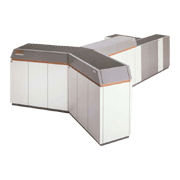In April 1983, NEC announced the first supercomputer to exceed 1 gigaFLOPS (1 billion floating point operations per second)—NEC supercomputer SX-2. This machine used 4 sets of high-performance vector operation pipelines (with up to a maximum of 16 arithmetic units) capable of multiple/parallel operation, and also used state-of-the-art technology such as new LSI high-density packages employing Japan's first direct liquid cooling system. This system achieved an ultra high-speed machine cycle of 6 nanoseconds, and were the world's fastest at 1.3 gigaFLOPS. At the same time, NEC supercomputer SX-1, which had a maximum speed of 570 megaFLOPS (million floating point operations per second) was also announced.
They used ultra high-speed LSI, including: logic elements with a delay time per gate of 250 picoseconds and 1,000 gates per chip, and memory elements with an access time of 3.5 nanoseconds and 1 kilobit per chip.
The vector operation pipeline system was a hardware architecture suitable for efficient, high-speed processing of SIMD (Single Instruction, Multiple Data) instructions for executing iterative operations described with a DO loop in a single instruction. This dramatically improved arithmetic performance, and the system was used in a variety of fields ranging from nuclear fusion and molecular science research, to aircraft and automobile design, and scientific applications like weather forecasting.
| SX-1 | SX-2 | |
|---|---|---|
| Announcement date | April 1983 | |
| Maximum vector operation performance | 570MFLOPS | 1.3GFLOPS |
| Arithmetic unit: Number of arithmetic processors Main memory capacity |
1 64KB |
|
| Main memory capacity | 64/128/256MB | 128/256MB |
| Number of input/output processors: Overall data transfer speed Number of input/output channels |
1 50MB/s Max. 32 |
|


